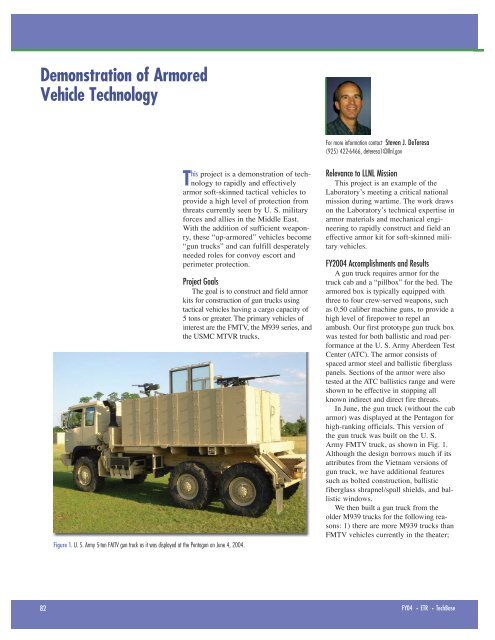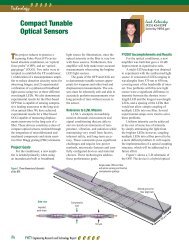Demonstration of Armored Vehicle Technology
Demonstration of Armored Vehicle Technology
Demonstration of Armored Vehicle Technology
Create successful ePaper yourself
Turn your PDF publications into a flip-book with our unique Google optimized e-Paper software.
<strong>Demonstration</strong> <strong>of</strong> <strong>Armored</strong><br />
<strong>Vehicle</strong> <strong>Technology</strong><br />
82<br />
Figure 1. U. S. Army 5-ton FMTV gun truck as it was displayed at the Pentagon on June 4, 2004.<br />
This project is a demonstration <strong>of</strong> technology<br />
to rapidly and effectively<br />
armor s<strong>of</strong>t-skinned tactical vehicles to<br />
provide a high level <strong>of</strong> protection from<br />
threats currently seen by U. S. military<br />
forces and allies in the Middle East.<br />
With the addition <strong>of</strong> sufficient weaponry,<br />
these “up-armored” vehicles become<br />
“gun trucks” and can fulfill desperately<br />
needed roles for convoy escort and<br />
perimeter protection.<br />
Project Goals<br />
The goal is to construct and field armor<br />
kits for construction <strong>of</strong> gun trucks using<br />
tactical vehicles having a cargo capacity <strong>of</strong><br />
5 tons or greater. The primary vehicles <strong>of</strong><br />
interest are the FMTV, the M939 series, and<br />
the USMC MTVR trucks.<br />
For more information contact Steven J. DeTeresa<br />
(925) 422-6466, deteresa1@llnl.gov<br />
Relevance to LLNL Mission<br />
This project is an example <strong>of</strong> the<br />
Laboratory’s meeting a critical national<br />
mission during wartime. The work draws<br />
on the Laboratory’s technical expertise in<br />
armor materials and mechanical engineering<br />
to rapidly construct and field an<br />
effective armor kit for s<strong>of</strong>t-skinned military<br />
vehicles.<br />
FY2004 Accomplishments and Results<br />
A gun truck requires armor for the<br />
truck cab and a “pillbox” for the bed. The<br />
armored box is typically equipped with<br />
three to four crew-served weapons, such<br />
as 0.50 caliber machine guns, to provide a<br />
high level <strong>of</strong> firepower to repel an<br />
ambush. Our first prototype gun truck box<br />
was tested for both ballistic and road performance<br />
at the U. S. Army Aberdeen Test<br />
Center (ATC). The armor consists <strong>of</strong><br />
spaced armor steel and ballistic fiberglass<br />
panels. Sections <strong>of</strong> the armor were also<br />
tested at the ATC ballistics range and were<br />
shown to be effective in stopping all<br />
known indirect and direct fire threats.<br />
In June, the gun truck (without the cab<br />
armor) was displayed at the Pentagon for<br />
high-ranking <strong>of</strong>ficials. This version <strong>of</strong><br />
the gun truck was built on the U. S.<br />
Army FMTV truck, as shown in Fig. 1.<br />
Although the design borrows much if its<br />
attributes from the Vietnam versions <strong>of</strong><br />
gun truck, we have additional features<br />
such as bolted construction, ballistic<br />
fiberglass shrapnel/spall shields, and ballistic<br />
windows.<br />
We then built a gun truck from the<br />
older M939 trucks for the following reasons:<br />
1) there are more M939 trucks than<br />
FMTV vehicles currently in the theater;<br />
FY04 • ETR • TechBase
2) the M939 truck is capable <strong>of</strong> handling<br />
10 tons on-road, while the FMTV is rated<br />
for only 5 tons either on- or <strong>of</strong>f-road; and<br />
3) the cab <strong>of</strong> the M939 is much easier to<br />
armor. We worked with the USMC to<br />
modify a cab armor that they had already<br />
produced for the M939 series trucks, and<br />
built a cab armor kit in just one week.<br />
This first Livermore gun truck started running<br />
convoy escort missions on July 17. A<br />
photo <strong>of</strong> the truck leaving Camp<br />
Anaconda is shown in Fig. 2. Since that<br />
time, the gun truck has been escorting<br />
convoys at least three times a week.<br />
Feedback from the Army has been very<br />
positive, and 28 more LLNL gun truck<br />
kits have been requested.<br />
We have also produced a second gun<br />
truck kit for the Marines’ MTVR. The<br />
armored box is similar to the one developed<br />
for the U. S. Army, but the hardware<br />
to mount the box to the truck box and the<br />
cab armor are modified for this vehicle.<br />
The MTVR gun truck (Fig. 3) was assembled<br />
and demonstrated for the Marines at<br />
Camp Pendleton. It is currently undergoing<br />
road testing at ATC.<br />
FY2005 Proposed Work<br />
We will continue our efforts in vehicle<br />
armor technology with funding from<br />
DARPA. This follow-on effort will include<br />
producing 30 kits for gun trucks; further<br />
refinement for the USMC MTVR; and<br />
new, weight-efficient armor materials<br />
and structures for both vehicle and personnel<br />
protection.<br />
Other Technologies<br />
Figure 2. An M939 series gun truck leaving Camp Anaconda, Balad, for its first convoy escort mission with the U. S. Army 7th<br />
Transportation Battalion.<br />
Figure 3. The USMC MTVR gun truck at ATC.<br />
FY04 • ETR • TechBase 83




